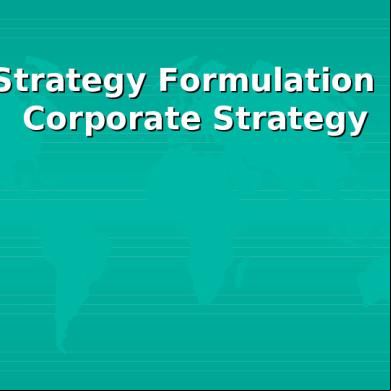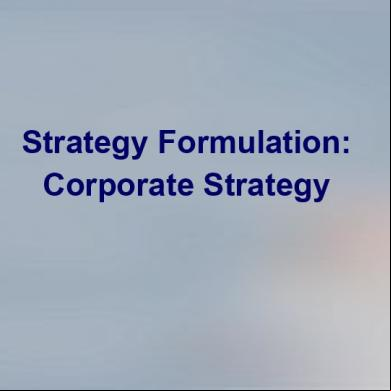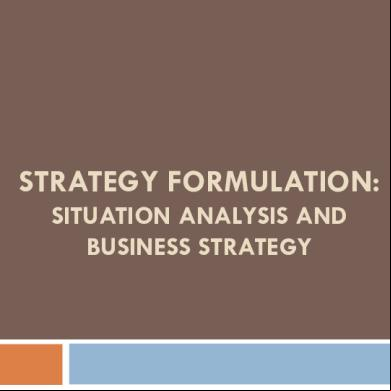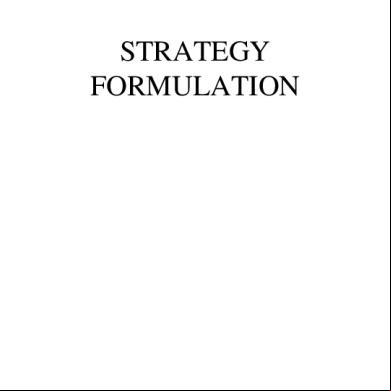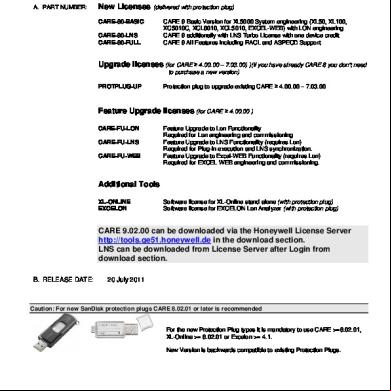(6)strategy Formulation, Corporate Strategy 5j5h1c
This document was ed by and they confirmed that they have the permission to share it. If you are author or own the copyright of this book, please report to us by using this report form. Report 2z6p3t
Overview 5o1f4z
& View (6)strategy Formulation, Corporate Strategy as PDF for free.
More details 6z3438
- Words: 1,112
- Pages: 24
Strategy Formulation : Corporate Strategy
Corporate Strategy • • •
Directional: orientation toward growth Portfolio Analysis: coordination of cash among units Corporate Parenting: building synergies among units through resource sharing
Corporate Directional Strategies • Growth Concentration Vertical Growth Horizontal Growth Diversification Concentric Conglomerate
• Retrenchment
• Stability
Turnaround
Pause/Proceed with Caution
Captive Company
No Change Profit
Sell-Out/Divestment Bankruptcy/Liquidation
International Entry Strategies • • • • • • • • •
Exporting Licensing t ventures Acquisitions Green-field development Production sharing Turnkey operations BOT concept Management contracts
Stability Strategies •
• •
Pause/Proceed with caution strategy : an opportunity to rest before continuing a growth or a retrenchment strategy No-change strategy : to continue current operations and do nothing new Profit strategy : an attempt to artificially profit by reducing investment and short term discretionary expenditures
Retrenchment Strategies •
• • •
Turnaround strategy : improve the operation efficiency. (contraction (stop the bleeding) and consolidation (stabilize the leaner operation) Captive company strategy: giving up independence in exchange for security Sell out : selling the entire firm to another firm Divestment : sell off a division with slow growth potential
•
•
Bankruptcy : giving up the management of the firm to the courts in exchange for some settlement of the company’s obligations Liquidation: the termination of a firm
Portfolio Analysis •
Top management views its products line and business units as a series of investments from which it expects a profitable return • This concept can also be used to develop strategies for international markets • Two approaches for portfolio analysis: 1. BCG Growth-Share Matrix 2. GE Business Screen
BCG Growth-Share Matrix • •
•
Is based on the product life cycle theory and the concept of the experience curve Each of the corporation’s product lines or business units is plotted on the matrix according to the growth rate of the industry in which it competes and its relative market share The matrix assumes that a growing market is attractive
BCG Growth-Share Matrix 22
Stars
Question Marks
Cash Cows
Dogs
18 16 14 12 10 8 6 4 2
Relative Competitive Position
0.1x
0.2x
0.5x 0.4x 0.3x
1x
2x 1.5x
4x
0 10x
Business Growth Rate (Percent)
20
Source: B. Hedley, “Strategy and the Business Portfolio,” Long Range Planning (February 1997), p. 12. Reprinted with permission.
Limitations of the BCG GrowthShare matrix • • • • •
The use of highs and lows to form 4 categories is too simplistic The link between market share and profitability is questionable Growth rate is only one aspect of industry attractiveness Product lines or business units are considered only in relation to one competitor, the market leader Market share is only one aspect of overall competitive position
GE Business Screen • •
• •
It includes more data than the BCG growth – share matrix Includes 9 cells based on long-term industry attractiveness and business strength/competitive position Industry attractiveness includes market growth rate, industry profitability, size, pricing practices Business strength includes market share, technological position, profitability, size
General Electric’s Business Screen High
Winners A
Winners B
C
Question Marks
Industry Attractiveness
D Winners E Medium
Average Businesses F Losers
Losers G Low
Profit Producers Strong
H
Losers Average
Weak
Business Strength/Competitive Position
Source: Adapted from Strategic Management in GE, Corporate Planning and Development, General Electric Corporation. Used by permission of General Electric Company.
Limitations of GE Business Screen • •
•
It can get complicated The numerical estimates of industry attractiveness and business strength could be subjective and vary from 1 person to another It cannot effectively depict the position of new products or business units in developing industries
International Portfolio Analysis • •
• •
Based on 2 factors: country attractiveness and a product’s competitive strength Country attractiveness is composed of market size, market growth rate, extent and type of government regulations Product’s competitive strength is composed of its market share, product fit, contribution margin and market Depending on where the product fits on the matrix, it should receive more funding or be harvested for cash
Portfolio Matrix for Plotting Products by Country Competitive Strengths Low
Country Attractiveness
High
High
Dominate/Divest t Venture
Invest/Grow
Low
Selective Strategies
Harvest/Divest Combine/License
Source: G. D. Harrell and R. O. Kiefer, “Multinational Strategic Market Portfolios,” MSU Business Topics (Winter 1981), p. 7. Reprinted by permission.
Advantages of Portfolio Analysis •
• •
It encourages top management to evaluate each business unit and to set objectives and allocate resources for each Encourages the use of external data to supplement management judgement Studies cash flow availability for use in expansion and growth
Limitations of Portfolio Analysis • • • • •
It is not easy to define product/market segments Standard strategies can miss opportunities or be impractical Is based on subjective judgment Industry attractiveness can be misleading May prevent corporations from improving the position of some viable products or business units
Corporate Parenting • •
What business should the company own and why? What organizational structure, management processes, and philosophy will foster superior performance from the company’s business units?
Corporate Parenting •
• • •
It views the corporation in of resources and capabilities that can be used to build business unit value as well as generate synergies across business units Multi-business companies create value by influencing – or parenting the businesses they own The best parent companies create more value than any of their rivals would if they owned the same business. Those companies have parenting advantage
Developing a Corporate Parenting Strategy 1. Examine each business unit (or target firm to be acquired) in of its strategic factors 2. Examine each business unit (or target firm) in of areas in which performance can be improved 3. Analyze how well the parent corporation fits with the business unit
Parenting Fit Matrix •
•
Is composed of 2 dimensions: the positive contribution that the parent can make and the negative effects the parent can make The combination of these two dimensions create five positions
Parenting-Fit Matrix MISFIT between critical success factors and parenting characteristics
Low Heartland Ballast Edge of Heartland
Alien Territory Value Trap
High Low
High FIT between parenting opportunities and parenting characteristics
Source: Adapted from M. Alexander, A. Campbell, and M. Goold, “A New Model for Reforming the Planning Review Process,” Planning Review (January/February 1995), p. 17. Reprinted by permission.
Horizontal Strategy and MultiPoint Competition •
•
Horizontal strategy : corporate strategy to achieve synergy among business units to improve their competitive position Multi-point competition: when large multi business corporations compete with other large multi business corporations in different markets, the corporate parent may help its business unit to improve competitive position in a specific market
Corporate Strategy • • •
Directional: orientation toward growth Portfolio Analysis: coordination of cash among units Corporate Parenting: building synergies among units through resource sharing
Corporate Directional Strategies • Growth Concentration Vertical Growth Horizontal Growth Diversification Concentric Conglomerate
• Retrenchment
• Stability
Turnaround
Pause/Proceed with Caution
Captive Company
No Change Profit
Sell-Out/Divestment Bankruptcy/Liquidation
International Entry Strategies • • • • • • • • •
Exporting Licensing t ventures Acquisitions Green-field development Production sharing Turnkey operations BOT concept Management contracts
Stability Strategies •
• •
Pause/Proceed with caution strategy : an opportunity to rest before continuing a growth or a retrenchment strategy No-change strategy : to continue current operations and do nothing new Profit strategy : an attempt to artificially profit by reducing investment and short term discretionary expenditures
Retrenchment Strategies •
• • •
Turnaround strategy : improve the operation efficiency. (contraction (stop the bleeding) and consolidation (stabilize the leaner operation) Captive company strategy: giving up independence in exchange for security Sell out : selling the entire firm to another firm Divestment : sell off a division with slow growth potential
•
•
Bankruptcy : giving up the management of the firm to the courts in exchange for some settlement of the company’s obligations Liquidation: the termination of a firm
Portfolio Analysis •
Top management views its products line and business units as a series of investments from which it expects a profitable return • This concept can also be used to develop strategies for international markets • Two approaches for portfolio analysis: 1. BCG Growth-Share Matrix 2. GE Business Screen
BCG Growth-Share Matrix • •
•
Is based on the product life cycle theory and the concept of the experience curve Each of the corporation’s product lines or business units is plotted on the matrix according to the growth rate of the industry in which it competes and its relative market share The matrix assumes that a growing market is attractive
BCG Growth-Share Matrix 22
Stars
Question Marks
Cash Cows
Dogs
18 16 14 12 10 8 6 4 2
Relative Competitive Position
0.1x
0.2x
0.5x 0.4x 0.3x
1x
2x 1.5x
4x
0 10x
Business Growth Rate (Percent)
20
Source: B. Hedley, “Strategy and the Business Portfolio,” Long Range Planning (February 1997), p. 12. Reprinted with permission.
Limitations of the BCG GrowthShare matrix • • • • •
The use of highs and lows to form 4 categories is too simplistic The link between market share and profitability is questionable Growth rate is only one aspect of industry attractiveness Product lines or business units are considered only in relation to one competitor, the market leader Market share is only one aspect of overall competitive position
GE Business Screen • •
• •
It includes more data than the BCG growth – share matrix Includes 9 cells based on long-term industry attractiveness and business strength/competitive position Industry attractiveness includes market growth rate, industry profitability, size, pricing practices Business strength includes market share, technological position, profitability, size
General Electric’s Business Screen High
Winners A
Winners B
C
Question Marks
Industry Attractiveness
D Winners E Medium
Average Businesses F Losers
Losers G Low
Profit Producers Strong
H
Losers Average
Weak
Business Strength/Competitive Position
Source: Adapted from Strategic Management in GE, Corporate Planning and Development, General Electric Corporation. Used by permission of General Electric Company.
Limitations of GE Business Screen • •
•
It can get complicated The numerical estimates of industry attractiveness and business strength could be subjective and vary from 1 person to another It cannot effectively depict the position of new products or business units in developing industries
International Portfolio Analysis • •
• •
Based on 2 factors: country attractiveness and a product’s competitive strength Country attractiveness is composed of market size, market growth rate, extent and type of government regulations Product’s competitive strength is composed of its market share, product fit, contribution margin and market Depending on where the product fits on the matrix, it should receive more funding or be harvested for cash
Portfolio Matrix for Plotting Products by Country Competitive Strengths Low
Country Attractiveness
High
High
Dominate/Divest t Venture
Invest/Grow
Low
Selective Strategies
Harvest/Divest Combine/License
Source: G. D. Harrell and R. O. Kiefer, “Multinational Strategic Market Portfolios,” MSU Business Topics (Winter 1981), p. 7. Reprinted by permission.
Advantages of Portfolio Analysis •
• •
It encourages top management to evaluate each business unit and to set objectives and allocate resources for each Encourages the use of external data to supplement management judgement Studies cash flow availability for use in expansion and growth
Limitations of Portfolio Analysis • • • • •
It is not easy to define product/market segments Standard strategies can miss opportunities or be impractical Is based on subjective judgment Industry attractiveness can be misleading May prevent corporations from improving the position of some viable products or business units
Corporate Parenting • •
What business should the company own and why? What organizational structure, management processes, and philosophy will foster superior performance from the company’s business units?
Corporate Parenting •
• • •
It views the corporation in of resources and capabilities that can be used to build business unit value as well as generate synergies across business units Multi-business companies create value by influencing – or parenting the businesses they own The best parent companies create more value than any of their rivals would if they owned the same business. Those companies have parenting advantage
Developing a Corporate Parenting Strategy 1. Examine each business unit (or target firm to be acquired) in of its strategic factors 2. Examine each business unit (or target firm) in of areas in which performance can be improved 3. Analyze how well the parent corporation fits with the business unit
Parenting Fit Matrix •
•
Is composed of 2 dimensions: the positive contribution that the parent can make and the negative effects the parent can make The combination of these two dimensions create five positions
Parenting-Fit Matrix MISFIT between critical success factors and parenting characteristics
Low Heartland Ballast Edge of Heartland
Alien Territory Value Trap
High Low
High FIT between parenting opportunities and parenting characteristics
Source: Adapted from M. Alexander, A. Campbell, and M. Goold, “A New Model for Reforming the Planning Review Process,” Planning Review (January/February 1995), p. 17. Reprinted by permission.
Horizontal Strategy and MultiPoint Competition •
•
Horizontal strategy : corporate strategy to achieve synergy among business units to improve their competitive position Multi-point competition: when large multi business corporations compete with other large multi business corporations in different markets, the corporate parent may help its business unit to improve competitive position in a specific market
